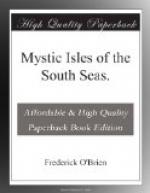The women are of middle size, with lines of harmony that give them a unique seal of beauty, with an undulating movement of their bodies, a coordination of every muscle and nerve, a richness of aspect in color and form, that is more sensuous, more attractive, than any feminine graces I have ever gazed on. They have the forwardness of boys, the boldness of huntresses, yet the softness and magnetism of the most virginal of their white sisters. One thinks of them as of old in soft draperies of beautiful cream-colored native cloth wound around their bodies, passed under one arm and knotted on the other shoulder, revealing the shapely neck and arm, and one breast, with garlands upon their hair, and a fragrant flower passed through one ear, and in the other two or three large pearls fastened with braided human hair.
The men never wore beards, though mustaches, copying the French custom, are common on chiefs, preachers, and those who sacrifice beauty and natural desires to ambition. The hair on the face is removed as it appears, and it is scanty. They abhor beards, and their ghosts, the tupapau, have faces fringed with hair. The usual movements of both men and women are slow, dignified, and full of pride.
Chapter IV
The Tiare Hotel—Lovaina the hostess, the best-known woman in the South Seas—Her strange menage—The Dummy—A one-sided tryst—An old-fashioned cocktail—The Argentine training ship.
The Tiare Hotel was the center of English-speaking life in Papeete. Almost all tourists stayed there, and most of the white residents other than the French took meals there. The usual traveler spent most of his time in and about the hotel, and from it made his trips to the country districts or to other islands. Except for two small restaurants kept by Europeans, the Tiare was the only eating-place in the capital of Tahiti unless one counted a score of dismal coffee-shops kept by Chinese, and frequented by natives, sailors, and beach-combers. They were dark, disagreeable recesses, with grimy tables and forbidding utensils, in which wretchedly made coffee was served with a roll for a few sous; one of them also offered meats of a questionable kind.
The Tiare Hotel was five minutes’ walk from the quay, at the junction of the rue de Rivoli and the rue de Petit Pologne, close by Pont du Remparts. It was a one-storied cottage, with broad verandas, half hidden in a luxuriant garden at the point where two streets come together at a little stone bridge crossing a brook—a tiny bungalow built for a home, and stretched and pieced out to make a guest-house.
I was at home there after a few days as if I had known no other dwelling. That is a distinctive and compelling charm of Tahiti, the quick possession of the new-comer by his environment, and his unconscious yielding to the demands of his novel surroundings, opposite as they might be to his previous habitat.




